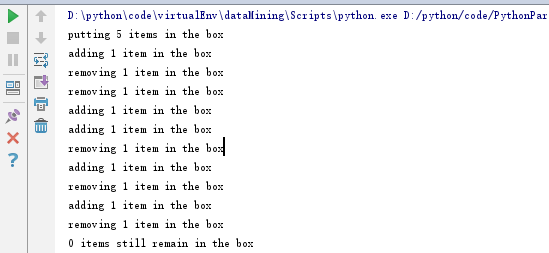1、基本概念
如果想让只有拿到锁的线程才能释放该锁,那么应该使用RLock()对象。当需要在类外面保证线程安全,又要在类内使用同样方法的时候RLock()就很使用。
RLock叫做Reentrant Lock,就是可以重复进入的锁,也叫递归锁。这种锁对比Lock有三个特点:1、谁拿到锁,谁释放;2、同一线程可以多次拿到该锁;3、acquire多少次就必须release多少次,只有最后一次release才能改变RLock的状态为unlocked。
2、RLock示例代码
# coding:utf-8 import threading import time class Box(object): lock = threading.RLock() def __init__(self): self.total_items = 0 def execute(self, n): Box.lock.acquire() self.total_items += n Box.lock.release() def add(self): Box.lock.acquire() self.execute(1) Box.lock.release() def remove(self): Box.lock.acquire() self.execute(-1) Box.lock.release() def adder(box, items): while items > 0: print("adding 1 item in the box") box.add() time.sleep(1) items -= 1 def remover(box, items): while items > 0: print("removing 1 item in the box") box.remove() time.sleep(1) items -= 1 if __name__ == "__main__": items = 5 print("putting %s items in the box" %items) box = Box() t1 = threading.Thread(target=adder, args=(box, items)) t2 = threading.Thread(target=remover, args=(box, items)) t1.start() t2.start() t1.join() t2.join() print("%s items still remain in the box " % box.total_items)
上述代码中adder()和remover()两个函数在Box类内操作items,即调用Box类的方法:add()和remove()。每一次方法调用,都会有一次拿到资源然后释放资源的过程。至于lock()对象,RLock()对象有acquire()和release()方法可以拿到或释放资源;每一次方法调用中,都有一下操作:
Box.lock.acquire()
do something
Box.lock.release()
运行结果如下:
